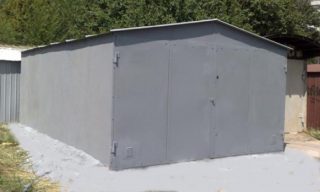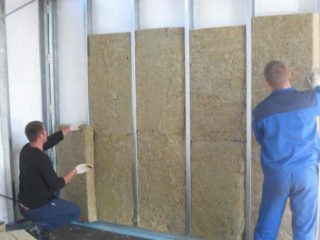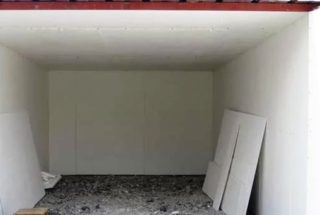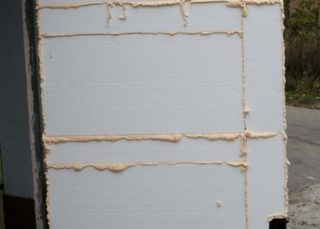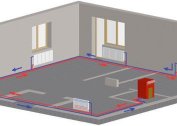For most car owners, it becomes especially important to resolve the issue of how to insulate the garage from the inside with your own hands. This is explained by the need to create comfortable conditions in the garage, as well as the desire to get rid of the condensate that spreads moisture. High-quality insulation of the garage is impossible without first selecting the appropriate thermal insulation and mastering the technology of its installation.
Optimum temperature conditions in the garage
Before you insulate the garage from the inside with your own hands, you need to consider that its metal walls are very thin, it does not make sense to heat such a room in the winter. To create normal conditions, it is reasonable to insulate it with available methods and means.
The optimum temperature from the point of view of the vehicle’s safety is +5 degrees. To maintain it in an iron garage, it will be necessary to arrange forced ventilation, providing an influx of fresh air in the amount of at least 180 m³ per hour per one car. For the safety of the machine, it is important not the absolute value of the temperature, but the provision of conditions guaranteeing low humidity.
Excessive heating of the internal spaces is more likely to do harm, as condensation will appear on metal surfaces. Properly organized ventilation plays an important role in this case, eliminating the possibility of the formation of harmful fumes. Therefore, motorists trying to raise the temperature inside the garage by plugging perfumes do the wrong thing. They allow you to maintain the necessary microclimate for the car. In addition, thanks to the ventilation openings, it is possible to remove carbon monoxide, as well as reduce the likelihood of moisture accumulation.
Technical parameters of insulation materials
Before warming the garage with available methods, you will need to choose the materials suitable for these purposes. First of all, thermal conductivity is taken into account, which provides effective insulation of metal walls. The absolute leader here is expanded polystyrene with a working indicator of 0.038 conventional units. Behind it are the following known insulation materials:
- mineral and glass wool (0.038 and 0.043, respectively;
- expanded clay (0.171);
- foam concrete (0.28).
- ceramic brick (0.519);
- cinder blocks - 0.64.
A layer of polystyrene foam with a thickness of 5 cm is equivalent to insulation from a meter cinder block coating.
Another important characteristic of the material chosen for the insulation of the garage is thermal inertia. This indicator takes into account the rate of change of temperature on the surface of the protective coating. Here the opposite is true - the cinder block wall has a large inertia (it heats up and cools longer). Thus, the right approach to the insulation of the garage is to choose a material, due to which the thermal inertia of the protection increases and its thermal conductivity decreases.
Since such a heat insulator simply does not exist in nature, a combined approach has been devised that allows you to keep the cold out in the winter during winter and protect them from heat in summer. For these purposes, modern technologies are used, involving the use of classic heaters in combination with reflective heat insulators.This approach can be easily implemented if the garage is attached to the house, in other cases it is not so effective.
But even in an attached garage from wall insulation there will be little use if you do not worry about the thermal insulation of the floor, roof and gate.
Types of insulation
Classic heaters for garages are traditionally selected from the following list:
- mineral wool materials;
- fiberglass heat insulators;
- polymer protective coatings (polystyrene foam or polyurethane foam).
The main requirements for thermal insulation are a low level of water permeability, which provides reliable protection of surfaces from excess moisture, as well as good fire resistance.
Mineral and glass wool
These inexpensive and popular materials are considered a good choice for thermal insulation of garage spaces, as they provide reliable protection. However, they have an increased hygroscopicity indicator, so their use is possible only with the preliminary waterproofing of structural elements. At the same time, the total costs of its insulation increase significantly.
Glass wool deserves special attention, which in terms of heat-shielding characteristics and price is comparable to its mineral counterpart. However, flammability and the need for protection against glass dust distributed during the installation of insulation blanks are added to its disadvantages. It is possible to protect the respiratory system when working with glass wool through a respirator or a protective mask.
Styrofoam / Styrofoam
Using one of these materials is the best option for warming a metal garage. With undoubted advantages, they are practically devoid of flaws. Polyfoam and expanded polystyrene (PP) are distinguished by excellent heat-insulating properties and do not allow moisture to pass through at all. They are stable in the bacteriological sense - they do not spread fungi and do not rot. Due to the ease of sheet blanks, they are easy to assemble and have a relatively low price.
The only drawback of warming garages with foam is the combustibility of the source material, which reduces the fire protection of the structure. However, there is a way out of this situation, consisting in the use of a special polystyrene of the PBS-S brand. This type of insulation in the production is treated with a flame retardant, which blocks the spread of fire.
Do-it-yourself wall insulation from the inside
The order of work is considered on the example of the use of foam (extruded polystyrene foam), which has all the qualities necessary for a heat insulator.
Insulating the walls of the garage with this type of PP is also allowed from the outside, for this sheet sheet blanks with a thickness of at least 20 mm will be required.
The sequence of insulation operations:
- On the internal walls of the structure, a frame base (crate) is prepared from a wooden beam.
- On it by means of a liquid adhesive composition is attached the first layer of protective material.
- A second layer of sheet insulation is glued on top.
When installing the coating, it is important to observe the offset of the sheets stacked in a checkerboard pattern, which eliminates the coincidence of the joint seams. Due to their reliable overlap, insulation will be most effective.
Garage door insulation
When insulating garage doors, the same methodology is used as when protecting the walls of the structure. Work order:
- A wooden crate is mounted, fastened on the base with self-tapping screws.
- The voids in the frame are laid with polystyrene plates (a special adhesive composition is used to fix them).
- Joints between sheets are glued with Isolon tape.
Decorating with suitable finishing materials will help to make the gate look attractive.
Roof insulation
If the garage is located separately from the apartment building, in addition to the walls, you will have to insulate the roof. Otherwise, the heated air will begin to rise and melt the snow, which will cause a temperature difference and the formation of condensate. Determine the insulation will help accounting material from which it is collected. If a wooden ceiling is made in the structure, foam boards are used, which are fixed by means of plastic dowels and closed on top by plywood sheets.
If concrete slabs were used during the installation of the walls and the overlap of the capital garage, it will be necessary to prepare the frame base from a metal profile. Its guides are fixed on the base planes with self-tapping screws, after which the plates themselves are laid on the resulting frame. If all the elements of the structure, including the roof, are assembled on the basis of corrugated board, they are insulated similarly to gates and walls of steel structures.
